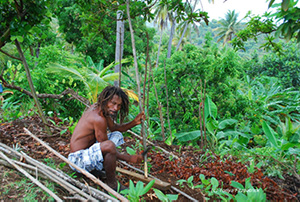Misty Mountains: The Ethnic Allure of Oaxaca

Photo: Nicholas Kontis
Posted April 30, 2025
A short flight southeast of Mexico City, the state of Oaxaca holds a mysterious allure for those who travel Latin America. Its culturally rich tapestry may be little more than a blip on the radar of those seeking glitzy beach resorts in Cancun, Los Cabos, and Puerto Vallarta. However, for those seeking authenticity, Oaxaca has no rival. Twenty distinct ethnic groups reside in the state. And, a full third of the population speaks an indigenous dialect.
A drive of fewer than three hours from Oaxaca City, the state capital, are the Sierra Mixe highlands. This region of small villages is linked by well-trodden trails rarely visited by outsiders. Here, travelers may interact with the land’s original inhabitants. This affords them a brief glimpse of their traditional way of life. It is a life-changing experience.
I joined tour guide Uriel Alcantara, owner of the Oaxaca-based Raiz Ayuuk agency, on a three-day Misty Mountain Hop. “The Mixe people are heirs to the Olmec culture, the ‘mother’ of our pre-Hispanic civilizations,” explained Alcantara. “This journey is a unique opportunity to genuinely connect with the oldest living roots of our ancestral heritage.”

Photo: Nicholas Kontis
From Village to Village
The trip began with visits to the villages of San Pedro and San Pablo Ayutla. There, local chef Regina Domínguez and her daughter, Julys, prepared a traditional dish of machucado. Families enjoy this Mixe ritual meal of cooked corn dough, accompanied by pepita (pumpkin) sauce and chilies, to ward off hunger and bond around the breakfast table.
Native artisans extensively utilize the myriad types of clay found throughout the Sierra Mixe, a direct result of the region’s varied weather patterns. “We have many microclimates in our region,” said Silvia Martinez, a celebrated ceramicist. “As clay needs to heat, cure, and bake, it can take days to weeks to complete our pieces.” At her workshop in the community of Tlahuitoltepec (“Tlahui”), we learned about the exquisite clay traditions of the Sierra.
At the workshop studio of ArteFer, we met master weaver and natural dyer Fernando Gutiérrez. Working alongside his wife, Paula, and their children, Xapaa and Rodrigo, Gutiérrez uses locally sourced palo de aguila (alder wood) tree bark in his garments. He explained the dyeing, loom weaving, and embroidery he uses to create colorful traditional and contemporary blouses, dresses, scarves, and shawls.

Photo: Nicholas Kontis
Continued Explorations
On the second day of our expedition, we climbed the Mixes’ sacred Zempoaltepetl Mountain, known as “Ipx Yukp” in their language. Accompanied by the mountain’s Santa Maria Yacochi guardians, it took our party of 12 just under four hours to reach the 11,483-foot summit. There, we participated in an ancestral ceremony to underscore the connection between man and nature as we asked for help and gave thanks.
On our final day, we visited Santa María Huitepec. We joined Juanita Elizondo, an esteemed traditional healer, midwife, and temazcal (sweat lodge) practitioner for breakfast. Then, we followed an interpretive trail past the community orchidarium to a swimming hole beneath a waterfall. En route, we passed through the ruins of the old town, which was evacuated in 1973 after intense rains followed an earthquake. The school, prison, and old church may still be seen.
We enjoyed freshly caught trout at El Buen Paladar restaurant at the Los Cedros farm, run by Sofía and Joel Jiménez. We then returned for one last overnight stay at Ayutla, where we sat around a campfire and enjoyed delicious Italian pizza with a touch of Oaxacan flavor: chapulines (toasted grasshoppers) and al pastor (spit-grilled pork).

PHoto: Nicholas Kontis
Oaxaca City
Back in Oaxaca City, the state capital, the 21st Century still seemed far away. Flaunting far more than its pretty churches, this Mexican enclave rivals any colonial destination in Latin America. Its refined Zocalo, the city’s central gathering plaza for 500 years, is a UNESCO World Heritage site.
Beginning here, in the historical hub of downtown, one cannot help but be mesmerized by the treasure trove of sites and places to explore. There are clandestine streets with painted murals, palatial churches, fashionable art galleries, massive markets selling all manner of artisanal products, an underrated but vibrant nightlife, rooftop bars—and mezcalerias.

Photos: Nicholas Kontis
Mezcal in Oaxaca
Oaxaca has more varieties of mezcal than any other region in Mexico. Its smoky agave flavor is unforgettable. Additionally, Oaxaca is renowned as the chocolate capital of Mexico, and chocolatiers seem to be on every street corner. Chocolate is also a typical ingredient in the state’s complex mole sauce. Even Oaxacan coffee is aromatic. For another glimpse into Oaxacan gastronomy and culture, Etnofood offers food classes and tours. These include mezcal tasting sessions, mole workshops, coffee tastings, vegan cooking classes, and chocolate shop tours. Visitors can join a gastronomic tour by electric bike through the city’s streets or walk to a local produce market to purchase ingredients for a salsa-making class.
With luck, you may encounter a calenda. A traditional celebration, such as a boda, or wedding, this event is highlighted by a pulsating afternoon parade through the streets of Oaxaca. Parades feature gigantic papier-mâché dancers that mimic the bride and groom. The all-inclusive event allows visitors to mingle with locals in a carnival setting.
And those who happen to be in Oaxaca in mid-autumn may want to stay for Día de los Muertos (Day of the Dead), Mexico’s most prominent and uniquely soulful festival.
Where to Stay
In the heart of Oaxaca, Parador de San Miguel, operated by the Tesoros Hotel group, offers a flawless, colonial-style boutique hotel located just three blocks from the Zocalo and the central market. Each colorful room showcases a traditional design style. A small garden and rooftop terrace add charm. The lobby restaurant, El Andariego, offers a diverse selection of delicious Mexican dishes.
Click Here for Discounted Accommodations in Oaxaca
Join the community!

Join our community to receive special updates (we keep your private info locked.)




